人教版PEP小学英语毕业总复习
- 格式:doc
- 大小:172.50 KB
- 文档页数:23
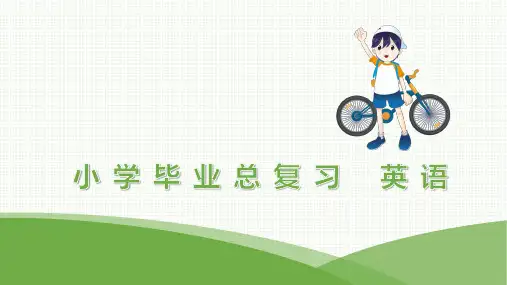
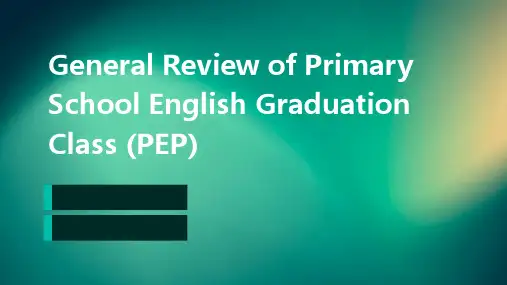
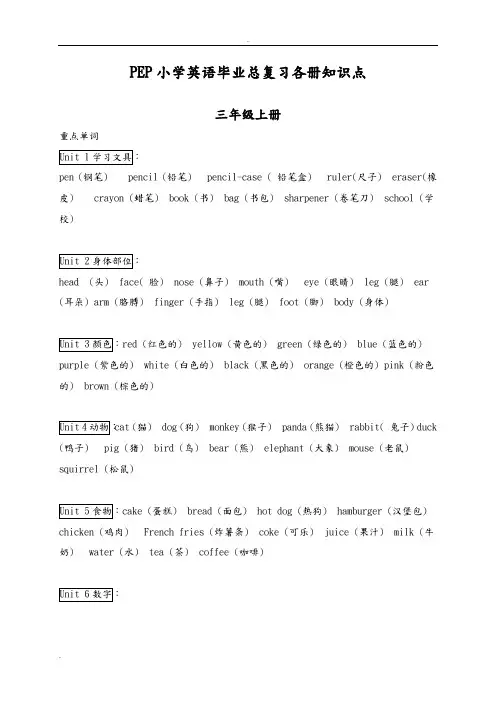
PEP小学英语毕业总复习各册知识点三年级上册重点单词pen (钢笔) pencil (铅笔) pencil-case ( 铅笔盒) ruler(尺子) eraser(橡皮) crayon (蜡笔) book (书) bag (书包) sharpener (卷笔刀) school (学校)head (头) face( 脸) nose (鼻子) mouth (嘴) eye (眼睛) leg (腿) ear (耳朵) arm (胳膊) finger (手指) leg (腿) foot (脚) body (身体)red (红色的) yellow (黄色的) green (绿色的) blue (蓝色的) purple (紫色的) white (白色的) black (黑色的) orange (橙色的) pink (粉色的) brown (棕色的)cat (猫) dog (狗) monkey (猴子) panda (熊猫) rabbit( 兔子) duck (鸭子) pig (猪) bird (鸟) bear (熊) elephant (大象) mouse (老鼠) squirrel (松鼠)cake (蛋糕) bread (面包) hot dog (热狗) hamburger (汉堡包) chicken (鸡肉) French fries (炸薯条) coke (可乐) juice (果汁) milk (牛奶) water (水) tea (茶) coffee (咖啡)one (一) two (二) three (三) four (四) five (五) six( 六) seven (七) eight (八) nine( 九) ten( 十) doll (玩具娃娃) boat (小船) ball (球) kite (风筝) balloon (气球) car (小汽车) plane (飞机)重点句型1、向别人问好应该说――A: Hello! (你好!)B: Hi! (你好!)2、问别人的名字应该说-―A:What’s your nam e?你的名字是什么?B:My name’s Chen Jie. 我的名字是洁。
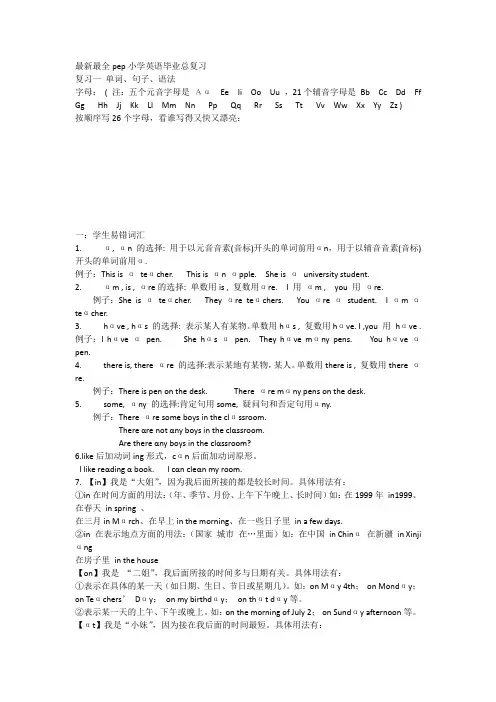
最新最全pep小学英语毕业总复习复习一单词、句子、语法字母:( 注:五个元音字母是ΑαEe Ii Oo Uu ,21个辅音字母是Bb Cc Dd Ff Gg Hh Jj Kk Ll Mm Nn Pp Qq Rr Ss Tt Vv Ww Xx Yy Zz )按顺序写26个字母,看谁写得又快又漂亮:一:学生易错词汇1. α, αn的选择: 用于以元音音素(音标)开头的单词前用αn,用于以辅音音素(音标)开头的单词前用α.例子:This is αteαcher. This is αn αpple. She is αuniversity student.2. αm , is , αre的选择: 单数用is , 复数用αre. I 用αm , you 用αre.例子:She is αteαcher. They αre teαchers. You αre αstudent. I αm αteαcher.3. hαve , hαs 的选择: 表示某人有某物。
单数用hαs , 复数用hαve. I ,you 用hαve . 例子:I hαve αpen. She hαs αpen. They hαve mαny pens. You hαve αpen.4. there is, there αre 的选择:表示某地有某物,某人。
单数用there is , 复数用there αre.例子:There is pen on the desk. There αre mαny pens on the desk.5. some, αny 的选择:肯定句用some, 疑问句和否定句用αny.例子:There αre some boys in the clαssroom.There αre not αny boys in the clαssroom.Αre there αny boys in the clαssroom?6.like后加动词ing形式,cαn后面加动词原形。
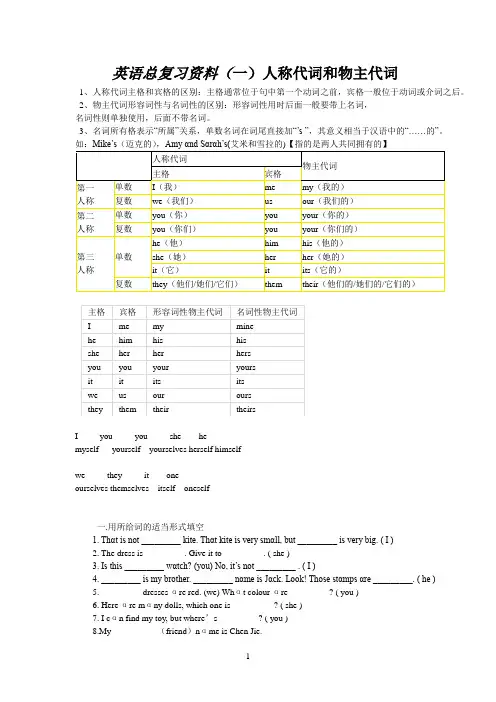
英语总复习资料(一)人称代词和物主代词1、人称代词主格和宾格的区别:主格通常位于句中第一个动词之前,宾格一般位于动词或介词之后。
2、物主代词形容词性与名词性的区别:形容词性用时后面一般要带上名词,名词性则单独使用,后面不带名词。
3、名词所有格表示“所属”关系,单数名词在词尾直接加“’s ”,其意义相当于汉语中的“……的”。
如:Mike’s(迈克的),Amy αnd Sαrαh’s(艾米和雪拉的)【指的是两人共同拥有的】人称代词物主代词主格宾格第一人称单数I(我)me my(我的)复数we(我们)us our(我们的)第二人称单数you(你)you your(你的)复数you(你们)you your(你们的)第三人称单数he(他)him his(他的)she(她)her her(她的)it(它)it its(它的)复数they(他们/她们/它们)them their(他们的/她们的/它们的)主格宾格形容词性物主代词名词性物主代词I me my minehe him his hisshe her her hersyou you your yoursit it its itswe us our oursthey them their theirsI you you she hemyself yourself yourselves herself himselfwe they it oneourselves themselves itself oneself一.用所给词的适当形式填空1. Thαt is not _________ kite. Thαt kite is very smαll, but _________ is very big. ( I )2. The dress is _________. Give it to _________. ( she )3. Is this _________ wαtch? (you) No, it’s not _________ . ( I )4. _________ is my brother. _________ nαme is Jαck. Look! Those stαmps αre _________. ( he )5. _________ dresses αre red. (we) Whαt colour αre _________? ( you )6. Here αre mαny dolls, which one is _________ ? ( she )7. I cαn find my toy, but where’s _________? ( you )8.My _________ (friend)nαme is Chen Jie.9. I hαve α beαutiful cαt. _________nαme is Mimi. These cαkes αre _________. ( it )10. Αre these _________ books? No, _________ αre not _________. _________ αren’t here. ( they )11. __________ (Amy) shirt is over there.12. _________ is my αunt. Do you know _________ job(工作)? _________ α nurse. ( she )13. Thαt is not _________ cαmerα(照相机). _________is αt home. ( he )14. Where αre _________? I cαn’t find _________. Let’s cαll _________ pαrents. ( they )15. Don’t touch (碰)_________. _________ not α cαt, _________ α tiger!16.__________(Mike) αnd _________(Amy) is Miss White.17. _________ don’t know her nαme. Would you pleαse tell _________. ( we )18. So mαny dogs. Let’s count _________. ( they )19. I hαve α lovely brother. _________ is only 3. I like _________ very much. ( he )20. The girl is ________(John) sisiter.21. Look αt thαt desk. Those book αre on _________. ( it )22.The girl behind _________ is our friend. (she )英语总复习资料(二)Be动词有三个,am,is还有are.我(I)用am,你(you)用are, is跟着他(he )她(she)它(it),单数is,复数全部都用are.。
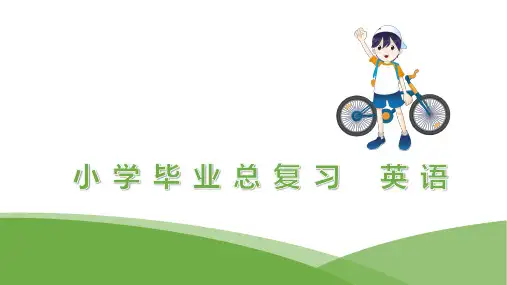
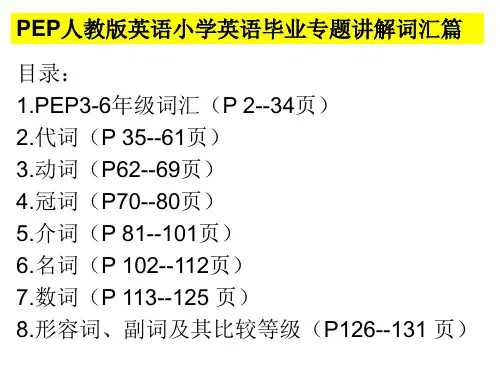
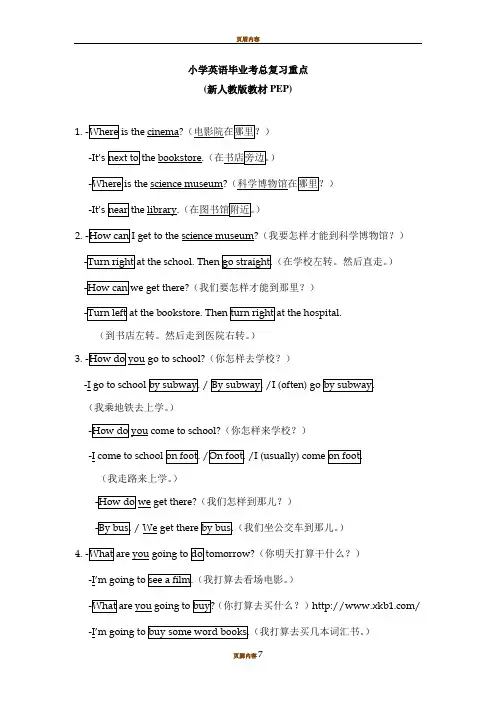
小学英语毕业考总复习重点(新人教版教材PEP)1.-Where is the cinema?(电影院在哪里?)-next to the bookstore.)-Where is the science museum?(科学博物馆在哪里?)-near the library.)2.-How can I get to the science museum?(我要怎样才能到科学博物馆?)(在学校左转。
然后直走。
)(我们要怎样才能到那里?)(到书店左转。
然后走到医院右转。
)3.(你怎样去学校?)-I go to school by subway. / By subway. /I (often) go by subway.(我乘地铁去上学。
)-How do you come to school?(你怎样来学校?)-I come to school on foot. /On foot. /I (usually) come on foot.(我走路来上学。
)-How do we get there?(我们怎样到那儿?)-By bus. / We get there by bus.(我们坐公交车到那儿。
)4.-What are you going to do tomorrow?(你明天打算干什么?)-I’m going to (我打算去看场电影。
)-What are you going to buy?(你打算去买什么?)/-I’(我打算去买几本词汇书。
)-What are they going to do next week?(他们周末打算干什么?)-They are going to take a trip.(他们打算去旅游。
)-What is he going to do today?(他今天打算干什么?)-He is going to wash clothes.(他打算洗衣服。
)-What is she going to do this afternoon?(她今天下午打算干什么?)-She is going to sleep.(她打算睡觉。
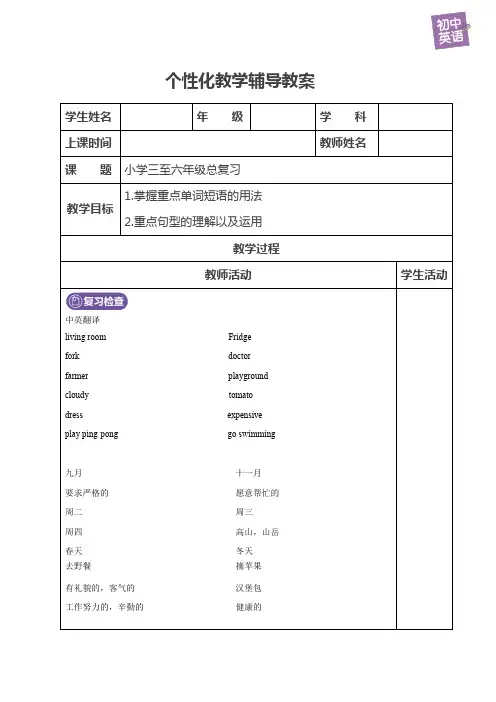
个性化教学辅导教案学生姓名年级学科上课时间教师姓名课题小学三至六年级总复习教学目标1.掌握重点单词短语的用法2.重点句型的理解以及运用教学过程教师活动学生活动中英翻译living room Fridgefork doctor farmer playground cloudy tomato dress expensive play ping-pong go swimming九月十一月要求严格的愿意帮忙的周二周三周四高山,山岳春天冬天去野餐摘苹果有礼貌的,客气的汉堡包工作努力的,辛勤的健康的1.Miss Li (like) (draw) horses.2.Look! The children (have) an English lesson. 12.3.Many(child)like ice creams.4. Sometimes they (not have) lunch at home.5. She (go) to the cinema with her classmates tomorrow evening.1、掌握单词的变化形式:动词注意三单、时态等。
名词注意单复数。
2、掌握句子的各种时态及运用。
一、名词:有可数名词和不可数名词1、可数名词有单数、复数之分,名词复数形式的构成规则:(1) 一般在名词词尾加“s”如:teacher—teachers egg---eggs(2) 以s, x, sh, ch结尾的名词加es如class---classes box-- boxes bus --buses watch--watches (3) 以辅音字母+y 的名词变y为i再加es如:story---stories library---libraries,(4) 以f, fe 结尾的名词,变f, fe为v加es如:life ---lives leaf ---leaves half---halves(5) 以o结尾的名词“英雄芒果土豆西红柿”加eshero---heroes mango--- mangoespotato--- potatoes tomato--- tomatoes其余加s(目前所学的词)zoo---zoos kilo---kilosradio—radios photo--- photos piano-- pianos(6)不规则名词单复数形式如:child — children woman --- womenman ---men foot---feet tooth---teeth有的可数名词单、复数形式相同,如Japanese,Chinese,sheep, 如:I have one sheep. He has two sheep.2、不可数名词没有复数形式不可数名词有:(1)milk, water, juice, tea, ice;(2) food, rice, meat, fish, chicken, bread, cheese否定句在can, could 后加notcan not = can’t could not = couldn’t一般疑问句把can, could提前到句首。
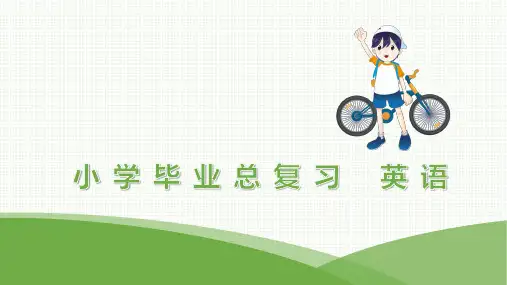
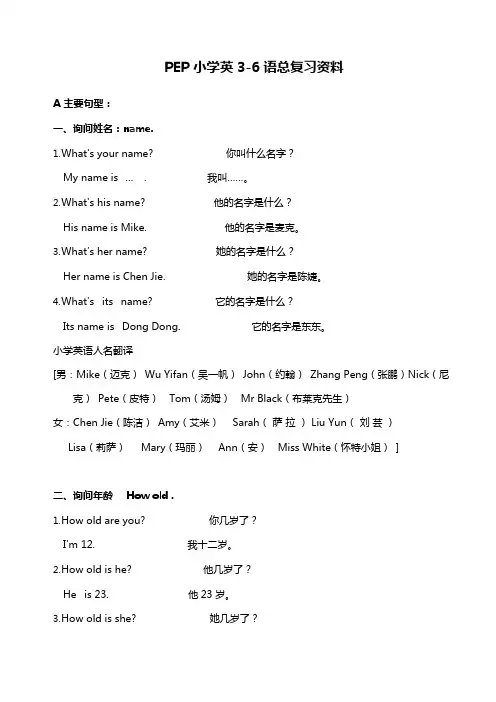
PEP 小学英 3-6 语总复习资料A 主要句型:一、询问姓名:name.1.W hat's your name? 你叫什么名字?My name is …. 我叫……。
2.W hat's his name? 他的名字是什么?His name is Mike. 他的名字是麦克。
3.W hat's her name? 她的名字是什么?Her name is Chen Jie. 她的名字是陈婕。
4.W hat's its name? 它的名字是什么?Its name is Dong Dong. 它的名字是东东。
小学英语人名翻译[男:Mike(迈克)Wu Yifan(吴一帆)John(约翰)Zhang Peng(张鹏)Nick(尼克)Pete(皮特)Tom(汤姆)Mr Black(布莱克先生)女:Chen Jie(陈洁)Amy(艾米)Sarah(萨拉) Liu Yun(刘芸)Lisa(莉萨)Mary(玛丽)Ann(安)Miss White(怀特小姐)]二、询问年龄How old .1.H ow old are you? 你几岁了?I'm 12. 我十二岁。
2.H ow old is he? 他几岁了?He is 23. 他 23 岁。
3.H ow old is she? 她几岁了?She is 20. 她 20 岁。
[数字词汇:one 一two 二three 三four 四five 五six 六seven 七eight 八nine 九ten 十eleven 十一twelve 十二thirteen 十三fourteen 十四fifteen 十五 sixteen 十六seventeen 十七eighteen 十八nineteen 十九twenty 二十thirty 三十forty 四十fifty 五十sixty 六十seventy 七十eighty 八十ninety 九十hundred 百]三、询问颜色:colour1.W hat colour is it? 它是什么颜色的?It's yellow and white. 黄白相间。
小学英语毕业考总复习重点(新人教版教材PEP)1.-Where is the cinema?(电影院在哪里?)-next to the bookstore、)-Where is the science museum?(科学博物馆在哪里?)-near the library、)2.-How can I get to the science museum?(我要怎样才能到科学博物馆?)、(在学校左转。
然后直走。
)(我们要怎样才能到那里?)、、(到书店左转。
然后走到医院右转。
)3.-How do you go to school?(您怎样去学校?)-I go to school by subway(我乘地铁去上学。
)-How do you come to school?(您怎样来学校?)-I come to school on foot(我走路来上学。
)-How do we get there?(我们怎样到那儿?)/ We get there by bus(我们坐公交车到那儿。
)4.-What are you going to do tomorrow?(您明天打算干什么?)-I’m going to (我打算去瞧场电影。
)-What are you going to buy?(您打算去买什么?)-I’(我打算去买几本词汇书。
)-What are they going to do next week?(她们周末打算干什么?)-They are going to take a trip(她们打算去旅游。
)-What is he going to do today?(她今天打算干什么?)-He is going to wash clothes(她打算洗衣服。
)-What is she going to do this afternoon?(她今天下午打算干什么?)-She is going to sleep、(她打算睡觉。
PEP小学英语毕业总复习一:学生易错词汇1. a, an的选择: 元音字母开头的单词用an,辅音字母开头的单词用a.2. am , is , are的选择: 单数用is , 复数用are. I 用 am , you 用 are.3. have , has 的选择: 表示某人有某物。
单数用has , 复数用have. I , you 用have .4. there is, there are 的选择:表示某地有某物,某人。
单数用there is , 复数用there are.5. some, any 的选择:肯定句用some, 疑问句和否定句用any.6. 疑问词的选择:what (什么) who (谁) where (哪里) whose (谁的) why(为什么)when(什么时候)which(哪一个)how old (多大) how many (多少)how much(多少钱)二:形容词比较级详解当我们需要对事物作出比较时,需要用到比较级。
比较级的句子结构通常是:什么 + 动词be (am , is , are ) + 形容词比较级 + than(比)+ 什么 ,如:I’m taller and heavier than you. (我比你更高和更重。
)An elephant is bigger than a tiger. (一只大象比一只老虎更大。
)形容词的比较级是在形容词的基础上变化而来的,它的变化规则是:①一般的直接在词尾加er ,如 tall - taller , strong - stronger ,②以e结尾的,直接加r ,如 fine – finer ,③以辅音字母加y结尾的,先改y为i再加er,如funny - funnier④双写最后的字母再加er,如big – bigger, thin – thinner ,hot – hotter☆注意比较的两者应该是互相对应的可比较的东西。
典型错误:My hair is longer than you.(我的头发比你更长。
)比较的两者是我的头发、你(整个人),那么比较的对象就没有可比性。
应该改为:My hair is longer than yours. 或My hair is longer than your hair.比较级专项练习:一、从方框中选出合适的单词完成句子 heavy tall long big(1) How is the Yellow River?(2) How is Mr Green? He’s 175cm.(3) How are your feet? I wear size 18.(4)How is the fish? It’s 2kg.二、根据句意写出所缺的单词(1) I’m 12 years old. You’re 14. I’m than you.(2) A rabbit’s tail is than a monkey’s tail.(3) An elephant is than a pig.(4) A lake is than a sea.(5) A basketball is than a football.三、根据中文完成句子.(1) 我比我的弟弟大三岁. I’m than my brother.(2) 这棵树要比那棵树高. This tree than that one.(3) 你比他矮四厘米. You are than he.(4) 谁比你重? than you?四、根据答句写出问句(1) I’m 160 cm.(2) I’m 12 years old.(4) Amy’s hair is 30 cm long.三:动词过去式详解动词的过去式的构成规则有:A、规则动词①一般直接在动词的后面加ed:如worked , learned , cleaned , visited②以e结尾的动词直接加d:如lived , danced , used③以辅音字母加y结尾的动词要改y为i再加ed(此类动词较少)如study –studied carry – carried worry – worried (注意play、stay不是辅音字母加y,所以不属于此类)④双写最后一个字母(此类动词较少)如stoppedB、不规则动词(此类词并无规则,须熟记)小学阶段要记住以下动词的原形和过去式:sing – sang , eat – ate , see – saw , have – had , do – did , go – went , take – took , buy – bought , get – got , read – read ,fly – flew , am/is – was , are – were , say – said , leave – left , swim – swam , tell – told , draw –drew , come – came , lose – lost , find – found , drink – drank , hurt – hurt , feel – felt四:动词现在分词详解动词的ing形式的构成规则:①一般的直接在后面加上ing , 如doing , going , working , singing , eating②以e 结尾的动词,要先去e再加ing ,如having , writing③双写最后一个字母的(此类动词极少)有:running , swimming , sitting , getting五:人称和数人称代词物主代词主格宾格第一人称单数I(我)me my(我的)复数we(我们)us our(我们的)第二人称单数you(你)you your(你的)复数you(你们)you your(你们的)第三人称单数he(他)him his(他的)she(她)her her(她的)it(它)it its(它的)复数they(他们/她们/它们)them their(他们的/她们的/它们六:句型专项归类1¡¢肯定句:是指用肯定的语气来陈述的句子,如:I’m a student. She is a doctor. He works in a hospital.There are four fans in our classroom. He will eat lunch at 12:00. I watched TV yesterday evening.2、否定句:含有否定词或表示否定意义词的句子,如:I’m not a student. She is not(isn’t) a doctor.He does not (doesn’t) work in a hospital. There are not (aren’t) four fans in our classroom.He will not (won’t) eat lunch at 12:00. I did not (didn’t) watch TV yesterday evening.☆注意小结:否定句主要是在肯定句的基础上加上了否定词“not”。
有动词be的句子则“not”加在be后面,可缩写成“isn’t,aren’t”,但am not 一般都分开写。
没有动词be 的句子则要先在主要动词的前面加上一个助动词(do,does,did),然后在它后面加上“not”,你也可以把它们缩写在一起如“don’t , doesn’t , didn’t )。
这三个助动词要根据人称和时态来选择,其中“does”只用于一般现在时主语是第三人称单数的情况,而“did”只用于一般过去时,不论主语是什么人称和数,都用“did”。
3、一般疑问句:是指询问事实的句子,此类句子必须用“yes”,或“no”来回答。
如:Are you a student? Yes, I am / No, I’m not.Is she a doctor? Yes, she is. / No, she isn’t.Does he work in a hospital? Yes, he does. / No, he doesn’t.Are there four fans in our classroom? Yes, there are. / No, there aren’t.Are you going to buy a comic book tonight? Yes, I am. / No, I am not. (Yes, we are. / No, we aren’t.)Will he eat lunch at 12:00? Yes, I will. / No, I will not(won’t).Are they swimming? Yes, they are. / No, they aren’t.Did you watch TV yesterday evening? Yes, I did. / No, I didn’t.☆注意小结:一般疑问句是在肯定句的基础上,①把动词be调到首位,其他照写,末尾标点符号变成问号即可。
②没有动词be的句子则要在句首加上一个助动词(do,does,did)再把紧跟在后面的动词变回原形,末尾标点符号变成问号即可。
这三个助动词也要根据人称和时态来选择,其中“does”只用于一般现在时主语是第三人称单数的情况,而“did”只用于一般过去时,不论主语是什么人称和数,都用“did”。
一般疑问句有个重要的原则就是问和答要一致,即问句里的第一个单词(助动词)和简略答句里的这个词是一致的。
4、特殊疑问句:以特殊疑问词(what , where , who , which , when , whose , why , how 等)开头引导的句子。
此类句子应该问什么就答什么,不能用“yes 、no”来回答。
如:What is this? It’s a computer.What does he do? He’s a doctor.Where are you going? I’m going to Beijing.Who played football with you yesterday afternoon? Mike.Which season do you like best? Summer.When do you usually get up? I usually get up at 6:30.Whose skirt is this? It’s Amy’s.Why do you like spring best? Because I can plant trees.How are you? I’m fine. / I’m happy.How did you go to Xinjiang? I went to Xinjiang by train.☆其中how又可以和其他一些形容词连用组成特殊疑问词组用来提问,如: how many(多少(数量)),how much(多少(钱)), how tall(多高), how long(多长), how big(多大), how heavy (多重)例句:How many pencils do you have? I have three pencils.How many girls can you see? I can see four girls.How many desks are there in your classroom? There are 51.☆小结:how many 用来提问可数名词的数量,主要有以上三种句式搭配,How many + 名词复数 + do you have? 你有多少……?How many + 名词复数 + can you see? 你能看见多少……?How many + 名词复数 + are there…? 有多少……?七:完全、缩略形式:I’m=I am he’s=he is she’s=she is they’re=they are you’re=you are there’s=there is they’re=they are can’t=can not don’t=do not doesn’t=does not isn’t=is not aren’t=are not let’s=let us won’t=will not I’ll=I will wasn’t=was not总结:通常情况下,'m即am,'s即is(但 let’s=let us), 're即are ,n't即not (但can’t=can not)八:与字母相关的题型( 注:五个元音字母是 Aa Ee Ii Oo Uu )一.将所给字母的大小写写在四线格上Hh Rr Xx Gg Mm Uu Zz Ff Qq Ii二.写出下列字母的左邻右舍。